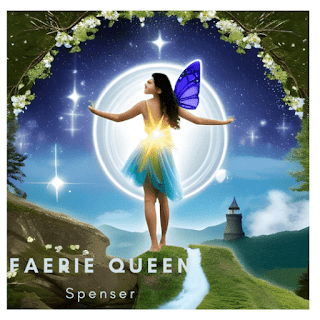The Faerie Queen: A Journey Through the Enchanted World
Are you looking for an epic poem that takes you on a magical
journey through an enchanted world? Look no further than "The Faerie
Queen" by Edmund Spenser. In this article, we'll dive deep into the summary
of "The Faerie Queen" by Spenser, explore its themes and characters,
and answer some frequently asked questions about this literary masterpiece.
Introduction
"The Faerie Queen" is an epic poem written by
Edmund Spenser in the late 16th century. It is considered one of the greatest
works of English literature, and it tells the story of a knight's journey
through the fantastical world of Faerie. The poem is divided into six books,
each focusing on a different virtue that the knight must embody.
The Summary of the "Faerie Queen" by Spenser
Book I introduces the Redcrosse Knight, who represents the
virtue of Holiness, and Una, his virtuous companion. They embark on a quest to
defeat the evil dragon, who represents the devil, and save Una's parents. Along
the way, they encounter a series of challenges, including the seductive Duessa,
who leads the knight astray.
Book II follows the knight Guyon, who represents the virtue
of Temperance, and his squire, the drunken Palmer. They travel to the Bower of
Bliss, where they encounter the sorceress Acrasia, who represents the deadly
sin of sensuality. Guyon defeats Acrasia and destroys the Bower, freeing the
prisoners who were held captive there.
Book III introduces Britomart, a female knight who
represents the virtue of Chastity. She sets out on a quest to find her true
love, who she has seen in a vision. Along the way, she encounters a series of
challenges, including the knight Artegall, who represents Justice, and the evil
enchantress Radigund.
Books IV, V, and VI continue the adventures of various
knights, each representing a different virtue. They encounter a wide range of
characters, both good and evil, and face many challenges along the way. In the
end, they all return to Faerie Queen Gloriana's court, where they are
celebrated for their heroic deeds.
Themes in "The Faerie Queen" by Spenser
- Virtue
and morality: Each book of "The Faerie Queen" focuses on a
different virtue that the knight must embody, emphasizing the importance
of living a virtuous life.
- Religion:
The poem is infused with religious symbolism and allegory, with many
characters and events representing biblical figures and stories.
- Gender
roles: The portrayal of female characters in "The Faerie Queen"
challenges traditional gender roles of the time, with Britomart being a
strong and independent female knight.
- Love
and romance: The theme of love is a recurring motif in the poem, with many
of the knights searching for their true love.
Characters in "The Faerie Queen" by Spenser
- Redcrosse
Knight: The hero of Book I, who represents the virtue of Holiness.
- Una:
Redcrosse Knight's virtuous companion who helps him on his quest.
- Duessa:
A deceptive character who leads Redcrosse Knight astray.
- Guyon:
The hero of Book II, who represents the virtue of Temperance.
- Acrasia:
The sorceress who embodies the deadly sin of sensuality.
- Britomart:
The female knight who represents the virtue of Chastity.
- Artegall:
The knight who represents Justice.
- Radigund:
The evil enchantress who challenges Britomart.
FAQs About "The Faerie Queen" by Spenser
- Why is
"The Faerie Queen" considered a masterpiece of English
literature?
- "The
Faerie Queen" is considered a masterpiece due to its intricate
allegory, complex characters, and beautiful language. Spenser's use of
symbolism and imagery has inspired countless literary works, and his
portrayal of heroic virtues continues to influence literature and culture
today.
- What
is the significance of the virtues represented in the poem?
- The
virtues represented in the poem, such as Holiness, Temperance, and
Chastity, were highly valued during Spenser's time. The poem emphasizes
the importance of living a virtuous life and the challenges that
individuals face in embodying these virtues.
- How
does Spenser use religion in the poem?
- Spenser
uses religious symbolism and allegory throughout the poem, drawing on
biblical stories and figures to convey his message. The character of
Redcrosse Knight, for example, represents the Christian virtue of
Holiness, while Una represents the Church.
- What
is the role of women in "The Faerie Queen"?
- The
portrayal of female characters in "The Faerie Queen" challenges
traditional gender roles of the time. Britomart, the female knight who
represents Chastity, is a strong and independent character who goes on a
quest to find her true love. Una, Redcrosse Knight's companion, is also
portrayed as virtuous and intelligent.
- What
is the significance of the enchanted world of Faerie?
- The
enchanted world of Faerie is a symbol of the human imagination and the
creative power of poetry. The fantastical creatures and settings in the
poem represent the beauty and wonder of the natural world, as well as the
dangers and temptations that humans face.
- How
has "The Faerie Queen" influenced literature and culture?
- "The
Faerie Queen" has had a profound influence on literature and culture,
inspiring countless writers and artists to create works of their own. Its
themes of morality and virtue continue to resonate with readers today, and
its use of allegory and symbolism has become a staple of literary fiction.
Conclusion
"The Faerie Queen" by Edmund Spenser is a
masterpiece of English literature that takes readers on a magical journey
through an enchanted world. Its intricate allegory, complex characters, and
beautiful language continue to inspire readers and writers today. Whether
you're a fan of epic poetry, allegory, or just great storytelling, "The
Faerie Queen" is a must-read.


